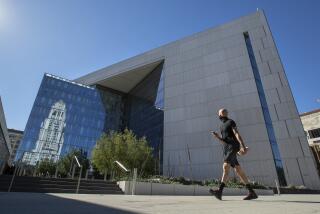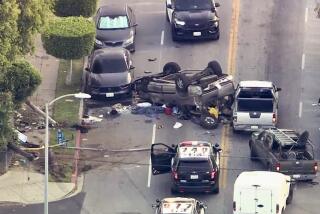LAPD Fired on Suspects 56 Times in ’04
Los Angeles police officers used serious force against suspects more times last year -- and were more likely to shoot at suspects -- than in 2003, according to a report presented Tuesday to the Los Angeles Police Commission.
But although last year’s 132 so-called categorical use of force incidents represented an 18% increase over 2003, LAPD officials said there is no trend toward increased aggressiveness by officers.
Rather, said Chief William J. Bratton, the increase reflects a combination of factors unrelated to officers’ behavior: improved reporting of such incidents, random variations and a 5% boost in arrests, which increased the chances of conflict between officers and suspects.
LAPD Inspector General Andre Birotte, whose office produced the report, concurred with Bratton, contending that the increase in use-of-force incidents does not appear to signal broad-scale change in officer conduct or attitudes.
The number of times officers shot at suspects, for example, was significantly higher in 2004 than in 2003, but no higher than the 2002 figure. That, said Birotte and LAPD officials, suggests that the numbers are subject to natural flux -- up one year, down the next. Officers fired on suspects 56 times in 2004, 44 times in 2003 and 56 times in 2002.
LAPD officers were slightly more likely to hit their targets in 2004, however. They missed 38% of the time, compared with 41% in 2003. And their hits were more lethal: Seventeen people died as a result of police gunfire in 2004, compared with 14 in 2003 and 15 in 2002.
The statistics are from internal LAPD reports, and they contradict those reported by Birotte in some instances. Birotte, however, conceded that his report contained some errors and called the LAPD internal figures more accurate.
Birotte said that part of the increase in other force incidents in 2004 -- a growth in the number that involves suspects being hospitalized, for example -- simply suggests that the LAPD is getting better at policing itself.
Investigators are working harder to track down suspects who are injured by police, and are categorizing more of the borderline cases as serious, he said.
Animal shootings by police officers also increased in 2004 over the previous two years but were not significantly different than in 2001.
There were fewer accidental discharges by officers in 2004, despite the fact that many switched to different weapon models in that year.
In all, LAPD officers resorted to serious force in only a fraction of incidents, less than a 10th of 1% of total arrests.
Bratton also argued that the degree of danger officers face should be considered when evaluating whether they are using appropriate force. One officer, Ricardo Lizarraga, was slain while on duty last year, Bratton said, underscoring the perils of the job.
But LAPD statistics show a more complicated picture. Suspects actually fired on LAPD officers fewer times last year than in 2003, but overall assaults with deadly weapons against officers increased.
In all, LAPD reports suggest that suspects try to use deadly means against officers more often than the reverse: Assaults with deadly weapons by suspects far outnumber the categorical uses of force by officers, LAPD statistics show.
There have been more police shooting incidents involving suspects than in the late 1990s, before Bratton became chief. But he said that, in general, police force statistics reflect favorable trends.
“The department is making extraordinary efforts to report uses of force,” he said. “We have a much more active department.”
More to Read
Sign up for Essential California
The most important California stories and recommendations in your inbox every morning.
You may occasionally receive promotional content from the Los Angeles Times.









